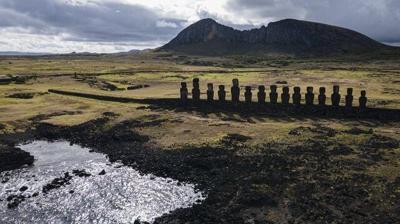By the end of the century, rising sea levels could push powerful seasonal waves into Easter IslandÎÚŃ»´«Ă˝ 15 iconic moai statues, according to a new study published in the Journal of Cultural Heritage. ÎÚŃ»´«Ă˝ 50 other cultural sites in the area are also at risk from flooding.
“Sea level rise is real,” said Noah Paoa, lead author of the study and a doctoral student at the University of Hawaii at ManoaÎÚŃ»´«Ă˝ School of Ocean and Earth Science and Technology. “ItÎÚŃ»´«Ă˝ not a distant threat.”
Paoa, who is from Easter Island — known to its Indigenous people as Rapa Nui — and his colleagues built a high-resolution “digital twin” of the islandÎÚŃ»´«Ă˝ eastern coastline and ran computer models to simulate future wave impacts under various sea level rise scenarios. They then overlaid the results with maps of cultural sites to pinpoint which places could be inundated in the coming decades.
The findings show waves could reach Ahu Tongariki, the largest ceremonial platform on the island, as early as 2080. The site, home to the 15 towering moai, draws tens of thousands of visitors each year and is a cornerstone of the islandÎÚŃ»´«Ă˝ tourism economy.
Beyond its economic value, the ahu is deeply woven into Rapa NuiÎÚŃ»´«Ă˝ cultural identity. It lies within Rapa Nui National Park, which encompasses much of the island and is recognized as a UNESCO World Heritage site.
The roughly 900 moai statues across the island were built by the Rapa Nui people between the 10th and 16th centuries to honor important ancestors and chiefs.
The threat isn't unprecedented. In 1960, the largest earthquake ever recorded — a magnitude 9.5 off the coast of Chile — sent a tsunami surging across the Pacific. It struck Rapa Nui and swept the already-toppled moai further inland, which damaged some of their features. The monument was restored in the 1990s.
While the study focuses on Rapa Nui, its conclusions echo a wider reality: cultural heritage sites worldwide are increasingly endangered by rising seas. A UNESCO report published last month found that about are highly exposed to coastal flooding.
In an email to The Associated Press, a UNESCO spokesperson said climate change is the biggest threat to UNESCOÎÚŃ»´«Ă˝ World Heritage marine sites. “In the Mediterranean and Africa, nearly three-quarters of coastal low-lying sites are now exposed to erosion and flooding due to accelerated sea level rise.”
Possible defenses for Ahu Tongariki range from armoring the coastline and building breakwaters to relocating the monuments.
Paoa hopes that the findings will bring these conversations about now, rather than after irreversible damage.
“ItÎÚŃ»´«Ă˝ best to look ahead and be proactive instead of reactive to the potential threats,” he said.
___
Follow Annika Hammerschlag on Instagram:
___
The Associated Press receives support from the Walton Family Foundation for coverage of water and environmental policy. The AP is solely responsible for all content. For all of APÎÚŃ»´«Ă˝ environmental coverage, visit

